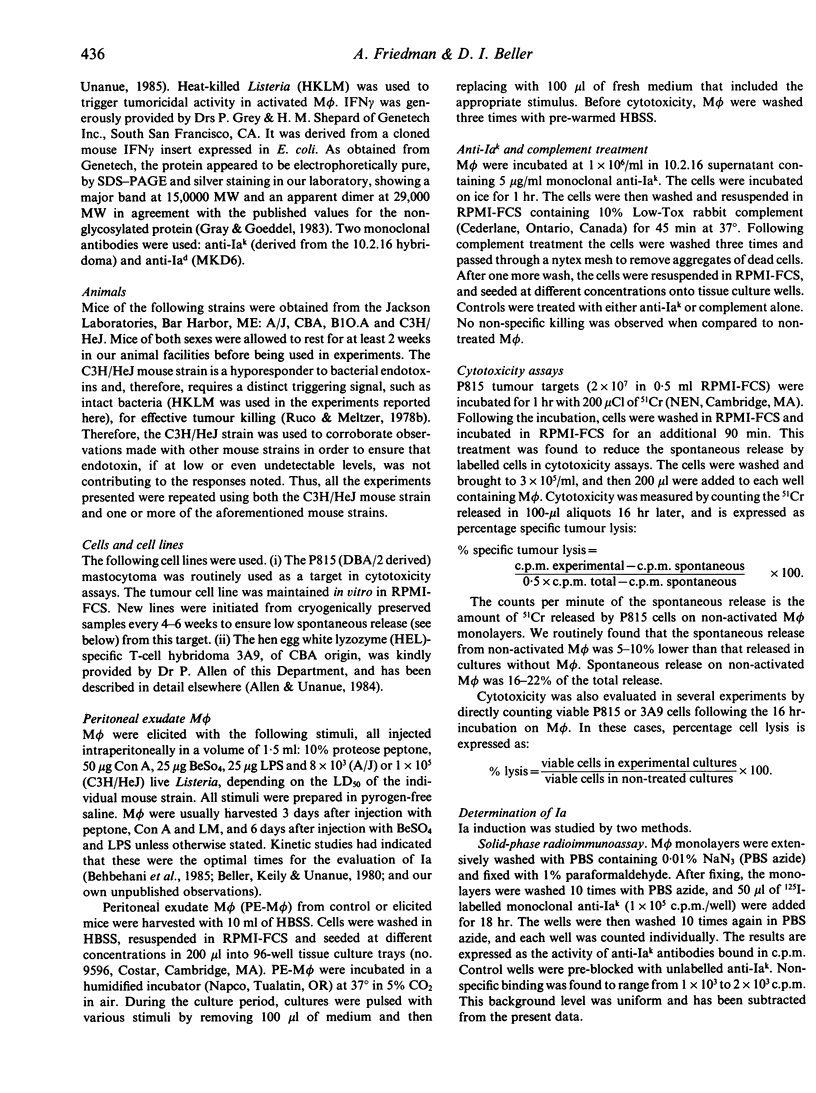Abstract
We have investigated whether the interrelationship of Ia expression and cytotoxicity by macrophages, as the two functions if expressed at the same time, might be counterproductive for T-cell development and function. We report that, under some circumstances, there is a clear dissociation of the two activities, as was demonstrated for both in vitro and in vivo conditions. However, the two functions could also be superimposed. Dissociation or superimposition was determined by (i) the nature of the inducing stimulus, and (ii) by the time-span between stimulation and evaluation. It was found that Ia and tumour killing were mainly expressed by the same macrophage population and, as a result, cytolytic activity, when associated with Ia expression, can be directed against T-cell hybridomas in an antigen-specific manner. The physiological relevance of the dissociation or superimposition of Ia expression and tumour killing by macrophages is discussed.
Full text
PDF






Selected References
These references are in PubMed. This may not be the complete list of references from this article.
- Allen P. M., Unanue E. R. Differential requirements for antigen processing by macrophages for lysozyme-specific T cell hybridomas. J Immunol. 1984 Mar;132(3):1077–1079. [PubMed] [Google Scholar]
- Behbehani K., Beller D. I., Unanue E. R. The effects of beryllium and other adjuvants on Ia expression by macrophages. J Immunol. 1985 Apr;134(4):2047–2049. [PubMed] [Google Scholar]
- Beller D. I. Functional significance of the regulation of macrophage Ia expression. Eur J Immunol. 1984 Feb;14(2):138–143. doi: 10.1002/eji.1830140207. [DOI] [PubMed] [Google Scholar]
- Beller D. I., Ho K. Regulation of macrophage populations. V. Evaluation of the control of macrophage Ia expression in vitro. J Immunol. 1982 Sep;129(3):971–976. [PubMed] [Google Scholar]
- Beller D. I., Kiely J. M., Unanue E. R. Regulation of macrophage populations. I. Preferential induction of Ia-rich peritoneal exudates by immunologic stimuli. J Immunol. 1980 Mar;124(3):1426–1432. [PubMed] [Google Scholar]
- Blasi E., Varesio L. Role of protein synthesis in the activation of cytotoxic mouse macrophages by lymphokines. Cell Immunol. 1984 Apr 15;85(1):15–24. doi: 10.1016/0008-8749(84)90273-9. [DOI] [PubMed] [Google Scholar]
- Blumenthal E. J., Roberts W. K., Vasil A., Talmage D. W. Macrophage activation: dissociation of cytotoxic activity from Ia-A antigen expression. Proc Natl Acad Sci U S A. 1983 Apr;80(7):2031–2035. doi: 10.1073/pnas.80.7.2031. [DOI] [PMC free article] [PubMed] [Google Scholar]
- Friedman A., Beller D. I. The effect of adherence on the in vitro induction of cytocidal activity by macrophages. Immunology. 1987 Aug;61(4):469–474. [PMC free article] [PubMed] [Google Scholar]
- Gray P. W., Goeddel D. V. Cloning and expression of murine immune interferon cDNA. Proc Natl Acad Sci U S A. 1983 Oct;80(19):5842–5846. doi: 10.1073/pnas.80.19.5842. [DOI] [PMC free article] [PubMed] [Google Scholar]
- Meltzer M. S., Ruco L. P., Boraschi D., Nacy C. A. Macrophage activation for tumor cytotoxicity: analysis of intermediary reactions. J Reticuloendothel Soc. 1979 Oct;26(4):403–415. [PubMed] [Google Scholar]
- Nacy C. A., Oster C. N., James S. L., Meltzer M. S. Activation of macrophages to kill rickettsiae and Leishmania: dissociation of intracellular microbicidal activities and extracellular destruction of neoplastic and helminth targets. Contemp Top Immunobiol. 1984;13:147–170. doi: 10.1007/978-1-4757-1445-6_8. [DOI] [PubMed] [Google Scholar]
- Rao A., Faas S. J., Miller L. J., Riback P. S., Cantor H. Lysis of inducer T cell clones by activated macrophages and macrophage-like cell lines. J Exp Med. 1983 Oct 1;158(4):1243–1258. doi: 10.1084/jem.158.4.1243. [DOI] [PMC free article] [PubMed] [Google Scholar]
- Roberts W. K., Vasil A. Evidence for the identity of murine gamma interferon and macrophage activating factor. J Interferon Res. 1982;2(4):519–532. doi: 10.1089/jir.1982.2.519. [DOI] [PubMed] [Google Scholar]
- Ruco L. P., Meltzer M. S. Macrophage activation for tumor cytotoxicity: development of macrophage cytotoxic activity requires completion of a sequence of short-lived intermediary reactions. J Immunol. 1978 Nov;121(5):2035–2042. [PubMed] [Google Scholar]
- Ruco L. P., Meltzer M. S. Macrophage activation for tumor cytotoxicity: tumoricidal activity by macrophages from C3H/HeJ mice requires at least two activation stimuli. Cell Immunol. 1978 Nov;41(1):35–51. doi: 10.1016/s0008-8749(78)80026-4. [DOI] [PubMed] [Google Scholar]
- Scher M. G., Unanue E. R., Beller D. I. Regulation of macrophage populations. III. The immunologic induction of exudates rich in Ia-bearing macrophages is a radiosensitive process. J Immunol. 1982 Jan;128(1):447–450. [PubMed] [Google Scholar]
- Schreiber R. D., Pace J. L., Russell S. W., Altman A., Katz D. H. Macrophage-activating factor produced by a T cell hybridoma: physiochemical and biosynthetic resemblance to gamma-interferon. J Immunol. 1983 Aug;131(2):826–832. [PubMed] [Google Scholar]
- Steeg P. S., Moore R. N., Johnson H. M., Oppenheim J. J. Regulation of murine macrophage Ia antigen expression by a lymphokine with immune interferon activity. J Exp Med. 1982 Dec 1;156(6):1780–1793. doi: 10.1084/jem.156.6.1780. [DOI] [PMC free article] [PubMed] [Google Scholar]


